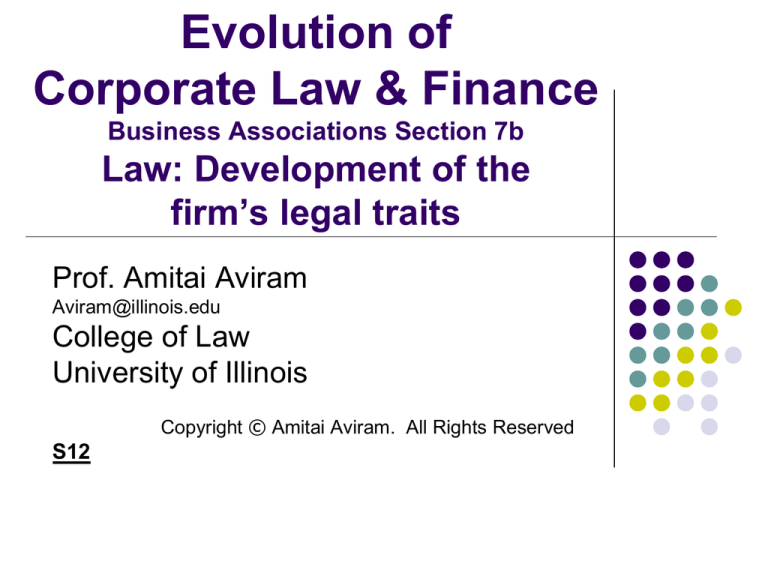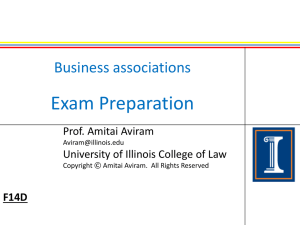
Evolution of
Corporate Law & Finance
Business Associations Section 7b
Law: Development of the
firm’s legal traits
Prof. Amitai Aviram
Aviram@illinois.edu
College of Law
University of Illinois
Copyright © Amitai Aviram. All Rights Reserved
S12
Law
Overview of Section 7b
Regulation of financial transactions
1.
Early views on lending & money
Regulation of lending by the Catholic Church
Regulation of lending in the common law & 20th century U.S.
2.
3.
History of the corporate entity
History of corporate governance
2
© Amitai Aviram. All rights reserved.
Law
Firm’s legal traits
Independent legal personality
Asset partitioning
Investor ownership (C acts to maximize SH welfare)
Centralized management
Limited liability (SH not liable for C’s obligations)
C not liable for SH’s liabilities
Managerial agency problem (holding managers accountable to SHs)
Majoritarian agency problem (protecting minority SHs)
Exit-focused dispute resolution
3
Restrictive dissolution / perpetual existence
Transferable shares
Capital lock-in
Copyright © Amitai Aviram. All Rights Reserved
Law
Development of firm’s legal traits
Independent legal personality
Asset partitioning
b3 c3
Whose welfare does C maximize? (SHs)
Centralized management
b2
Limited liability (SH not liable for C’s obligations)
C not liable for SH’s liabilities
Investor ownership
a4 b2
b3
Managerial agency problem (holding managers accountable to SHs)
Majoritarian agency problem (protecting minority SHs)
Alienability of ownership (exit-focused dispute resolution)
4
Restrictive dissolution / perpetual existence
a3
Transferable shares
Capital lock-in
Copyright © Amitai Aviram. All Rights Reserved
Law
Corporation’s legal traits
But before we discuss corporate law, let’s discuss the
evolution & regulation of financial transactions
Evolution & regulation of financing techniques
Evolution & regulation of financial intermediaries
5
Bilateral lending (usury laws)
Bills of exchange & other payment systems
Bond financing
Banks
Securities exchanges
Insurance
Copyright © Amitai Aviram. All Rights Reserved
Law
Overview of Section 7b
Regulation of financial transactions
History of the corporate entity
1.
2.
Demand for limited liability
Early forms of limited liability
Pre-modern attitudes towards limited liability
Could limited liability have developed without corporations?
The evolution of limited liability in corporations
Asset partitioning and the development of business entity law
3.
History of corporate governance
6
© Amitai Aviram. All rights reserved.
Why (or when) is
legal personality important?
We already discussed that in section (a)2
(Biz entity vs. contract)
Use of a business entities (rather than Ks)
benefits from economies of scale
7
Contracts are easily tailored to specific needs
of parties
But if there are many parties involved,
managing all the relationships is very complex
Copyright © Amitai Aviram. All Rights Reserved
Why (or when) is
limited liability important?
“[I]f [limited liability] simply does not matter—then what
are we to make of our inherited wisdom that it was key
to the emergence of the modern business organization
and thus to the development of modern commercial
society?
[…] Clearly, limited liability meant something to
someone. The question is what and to whom?”
- Amalia D. Kessler, Limited Liability in Context: Lessons from the French
Origins of the American Limited Partnership, 32 J. Legal Stud. 511 (2003)
8
Copyright © Amitai Aviram. All Rights Reserved
Why is ltd. liability important?
9
Copyright © Amitai Aviram. All Rights Reserved
Explaining the popularity of the
sole proprietorship
Sole proprietorships are, by far, the most common
business entity in the U.S.
Account for 66.4% of California 2002 tax returns (excluding
individuals and exempt organizations)
How can we explain the popularity
of a business entity that doesn’t
offer limited liability?
10
Copyright © Amitai Aviram. All Rights Reserved
Explaining the popularity of the
sole proprietorship
Explanation 1: People are irrational or poorly informed
11
Copyright © Amitai Aviram. All Rights Reserved
Explaining the popularity of the
sole proprietorship
Explanation 2(a): Personal liability not unique to SPs
12
Bob, a wealthy businessman, forms Bobco, Inc.
He invests $100 in the corporation, which has no other
assets. Bobco applies for a $10,000 loan from a bank.
You are the bank manager. Under what conditions will you
lend to Bobco?
Copyright © Amitai Aviram. All Rights Reserved
Explaining the popularity of the
sole proprietorship
Explanation 2(b): Some personal liability is avoidable
even in a SP
Carol operates a SP that owns a small apartment building
and collects about $3,000 in rent each month
The building needs renovations that cost $10,000. Carol has
considerable savings, but would rather borrow money for the
renovation so that she can deduct interest payments.
But she doesn’t want to be personally liable on the loan
Will the bank agree to limit her liability?
13
Non-recourse loan
Copyright © Amitai Aviram. All Rights Reserved
Demand for limited liability
Explaining the SP’s popularity
But what about torts?
14
Copyright © Amitai Aviram. All Rights Reserved
Demand for limited liability
Explaining the SP’s popularity
Dan opens a solo law firm, and chooses to incorporate
as DanCo, Inc.
Assume that law firms are allowed to incorporate in that state
Dan forgets to file a client’s brief on time, and the
client’s suit is dismissed.
The client sues for malpractice and wins a judgment.
However, DanCo has no assets.
15
Does the client have a cause of action against Dan
personally?
Copyright © Amitai Aviram. All Rights Reserved
Demand for limited liability
Explaining the SP’s popularity
Disliking the costs and formalities of operating a
corporation and seeing that it doesn’t protect him from
malpractice liability, Dan dissolves the corporation and
continues operating the law firm as a sole
proprietorship
Again he commits malpractice
16
Any difference in the liability?
Copyright © Amitai Aviram. All Rights Reserved
Demand for limited liability
Explaining the SP’s popularity
Despite his gross negligence, Dan’s law firm prospers. To
handle additional business, he hires two more attorneys as
associates (the law firm remains his sole proprietorship).
One of Dan’s attorneys now commits malpractice in the course
of working for Dan’s law firm. Dan was not consulted in the
negligent actions, nor was he negligent in supervising the
employee.
17
Is Dan liable for the malpractice?
Would he be liable if the law firm were a corporation?
Copyright © Amitai Aviram. All Rights Reserved
Demand for limited liability
Summing up
Liability in Contracts
Counterparty can waive personal liability
But will insist on personal liability if firm is poorly capitalized
Cost of individual opt-outs w/ # of contracts firm makes
Liability in Torts
Owner directly liable for:
18
Torts she personally commits
Torts of employees she failed to supervise
But not for torts of employees whom she has no duty to
supervise
Copyright © Amitai Aviram. All Rights Reserved
Demand for limited liability
Summing up
Liability in Contracts
LL makes little difference when firm has few contracts
LL saves costs as # of contracts increases & # of people in
firm who enter contracts increases
Liability in Torts
LL makes little difference in firm in which owner is either sole
employee of directly supervises all employees
LL reduces owner’s risk when:
19
Firm has employees that the owner does not have to supervise
Owner doesn’t work at firm (passive investor)
Copyright © Amitai Aviram. All Rights Reserved
Demand for limited liability
Summing up
What does this tell us about the development of
business entities?
Little pressure for limited liability business entities in firms
that have few employees, and in which owners are
employees and supervise others
We would expect to see increased pressure for limited
liability business entities as firm has:
20
More employees
More contracts with third parties
Passive investors
Employees with skills that owners are unable to supervise
Copyright © Amitai Aviram. All Rights Reserved
Law
Overview of Section 7b
Regulation of financial transactions
History of the corporate entity
History of corporate governance
1.
2.
3.
21
Evolution of the board of directors
Intervention solutions to the agency problem: ultra vires & the BJR
Voice solutions to the agency problem: shareholder voting
Exit solutions to the agency problem: dissolution & dissociation
© Amitai Aviram. All rights reserved.
The agency problem
Managing the “Sleepyville Snoozers”
Sleepyville, a town of 1K people, has a minor league
baseball team called the Sleepyville Snoozers
Olivia, a resident, hears that the owner is moving to
another state & plans to move the team with him
Team breaks even but doesn’t make a profit
She suggests buying the team to keep it in town
Owner will sell for $10M
22
Requires each resident to pay $10K
$10K/person is too much for most residents
And not all residents care about the team
Copyright © Amitai Aviram. All Rights Reserved
The agency problem
Managing the “Sleepyville Snoozers”
Olivia instead suggests raising the money via internet
23
Plan: 100K people will invest $100 ea. in Snoozer Inc.
Snoozer raises $10M, buys team
Team’s games to be broadcasted
live on internet to the owners
Copyright © Amitai Aviram. All Rights Reserved
The agency problem
Managing the “Sleepyville Snoozers”
Olivia’s plan for managing the team:
Team hires a coach
Coach makes proposals
Owners hold online vote on each proposal
Efficiency problem: Coaches unwilling to work under these
terms. Why?
Agency problem: Olivia suggests instead that the coach will
make all decisions himself, without owner interference
Any risk that the coach will abuse his power?
Another solution?
24
Hint: Gevurtz article
Copyright © Amitai Aviram. All Rights Reserved
The agency problem
Managing the “Sleepyville Snoozers”
This is the central tension in corporate law
Efficient operation
of the business
25
Minimizing agency costs
(agent shirking/stealing)
Copyright © Amitai Aviram. All Rights Reserved
Solutions to the agency problem
Three Arch-types of solutions to mitigate the agency
problem of insiders (directors/officers/controllers)
Litigatory
Substance: authority constraints;
fiduciary duties
Procedure: derivative actions;
SH inspection rights
Structural
Market
Voting for directors
Market for corporate control
Tying compensation to profits
Frequent need to raise capital
26
Copyright © Amitai Aviram. All Rights Reserved
Solutions to the agency problem
Litigatory
BJR (Allen, Hovenkamp)
Ultra vires (Hovenkamp)
Structural
27
Market
Copyright © Amitai Aviram. All Rights Reserved
Solutions to the agency problem
Litigatory
Structural
Market
SH voting (Dunlavy)
(Democratic/Oligarchic)
28
Copyright © Amitai Aviram. All Rights Reserved
Solutions to the agency problem
Litigatory
Structural
Market
Frequent need to raise capital
“Capital lock-in”
29
Copyright © Amitai Aviram. All Rights Reserved
Centralized management
Functions of Boards of Directors
Advisory board
1.
Directors add value through their prestige and contacts
Discouraged by increased focus on fiduciary duties
Supervisory board
2.
30
Directors add value through their supervision of the officers
May be discouraged by liability for unknown problems
(conscious disregard of duties)
Copyright © Amitai Aviram. All Rights Reserved
Centralized management
Functions of Boards of Directors
Executive board
3.
Directors add value through managing the company
Common in small firms; problem in large firms: who
supervises BoD?
Representative board
4.
Directors monitor company on behalf of stakeholders that
they represent
31
E.g., particular SH, labor union, government
Directors add value by creating trust between corporation &
stakeholder
Can be combined with other roles (often supervisory)
Copyright © Amitai Aviram. All Rights Reserved





